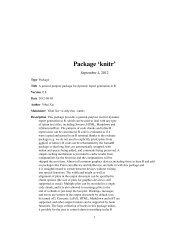Package 'openair'
Package 'openair'
Package 'openair'
You also want an ePaper? Increase the reach of your titles
YUMPU automatically turns print PDFs into web optimized ePapers that Google loves.
TaylorDiagram 115colsrms.colcor.colarrow.lwdkeyDetailskey.titlekey.columnsColours to be used for plotting. Useful options for categorical data are avilablefrom RColorBrewer colours — see the openair openColours function formore details. Useful schemes include “Accent”, “Dark2”, “Paired”, “Pastel1”,“Pastel2”, “Set1”, “Set2”, “Set3” — but see ?brewer.pal for the maximumuseful colours in each. For user defined the user can supply a list of colournames recognised by R (type colours() to see the full list). An example wouldbe cols = c("yellow", "green", "blue").Colour for centred-RMS lines and text.Colour for correlation coefficient lines and text.Width of arrow used when used for comparing two model outputs.Should the key be shown?Title for the key.Number of columns to be used in the key. With many pollutants a single columncan make to key too wide. The user can thus choose to use several columns bysetting columns to be less than the number of pollutants.key.pos Position of the key e.g. “top”, “bottom”, “left” and “right”. See details inlattice:xyplot for more details about finer control.stripauto.textShould a strip be shown?Either TRUE (default) or FALSE. If TRUE titles and axis labels will automaticallytry and format pollutant names and units properly e.g. by subscripting the ‘2’ inNO2.... Other graphical parameters are passed onto cutData and lattice:xyplot. Forexample, TaylorDiagram passes the option hemisphere = "southern" onto cutData to provide southern (rather than default northern) hemisphere handlingof type = "season". Similarly, common graphical parameters, such aslayout for panel arrangement and pch and cex for plot symbol type and size,are passed on to xyplot. Most are passed unmodified, although there are somespecial cases where openair may locally manage this process. For example,common axis and title labelling options (such as xlab, ylab, main) are passedvia quickText to handle routine formatting.The Taylor Diagram is a very useful model evaluation tool. Details of the diagram can be found athttp://www-pcmdi.llnl.gov/about/staff/Taylor/CV/Taylor_diagram_primer.pdf. The diagramprovides a way of showing how three complementary model performance statistics varysimultaneously. These statistics are the correlation coefficient R, the standard deviation (sigma)and the (centred) root-mean-square error. These three statistics can be plotted on one (2D) graphbecause of the way they are related to one another which can be represented through the Law ofCosines.The openair version of the Taylor Diagram has several enhancements that increase its flexibility.In particular, the straightforward way of producing conditioning plots should prove valuable undermany circumstances (using the type option). Many examples of Taylor Diagrams focus on modelobservationcomparisons for several models using all the available data. However, more insightcan be gained into model performance by partitioning the data in various ways e.g. by season,
















